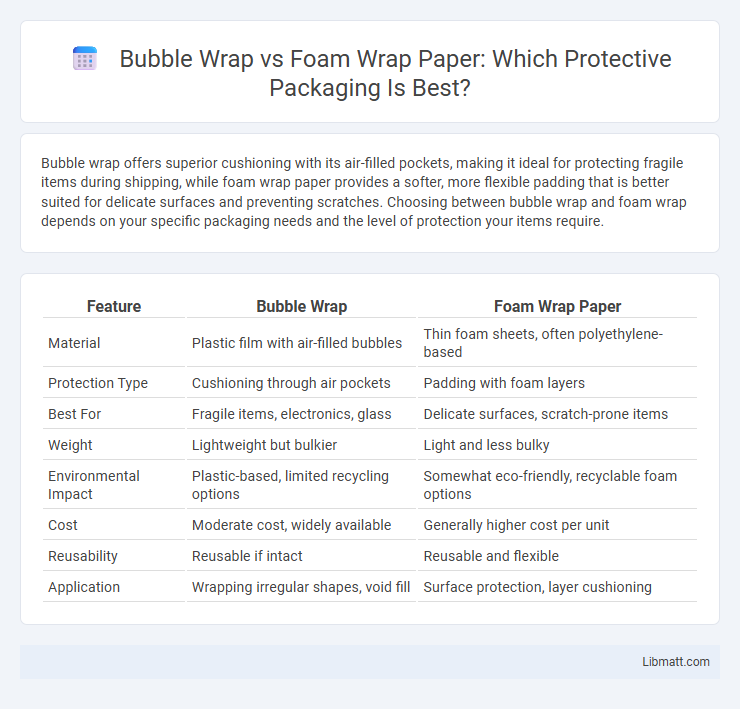Bubble wrap offers superior cushioning with its air-filled pockets, making it ideal for protecting fragile items during shipping, while foam wrap paper provides a softer, more flexible padding that is better suited for delicate surfaces and preventing scratches. Choosing between bubble wrap and foam wrap depends on your specific packaging needs and the level of protection your items require.
Table of Comparison
| Feature | Bubble Wrap | Foam Wrap Paper |
|---|---|---|
| Material | Plastic film with air-filled bubbles | Thin foam sheets, often polyethylene-based |
| Protection Type | Cushioning through air pockets | Padding with foam layers |
| Best For | Fragile items, electronics, glass | Delicate surfaces, scratch-prone items |
| Weight | Lightweight but bulkier | Light and less bulky |
| Environmental Impact | Plastic-based, limited recycling options | Somewhat eco-friendly, recyclable foam options |
| Cost | Moderate cost, widely available | Generally higher cost per unit |
| Reusability | Reusable if intact | Reusable and flexible |
| Application | Wrapping irregular shapes, void fill | Surface protection, layer cushioning |
Introduction to Bubble Wrap and Foam Wrap Paper
Bubble wrap consists of plastic sheeting with air-filled bubbles that provide cushioning for fragile items, ensuring impact resistance during shipping or storage. Foam wrap paper offers a soft, flexible layer made from polyethylene foam designed to protect surfaces from scratches and minor impacts. Understanding the differences between bubble wrap and foam wrap paper helps you choose the most suitable packaging material to safeguard your products effectively.
Key Differences Between Bubble Wrap and Foam Wrap
Bubble wrap consists of air-filled plastic bubbles providing cushioning and impact resistance, making it ideal for fragile items during shipping. Foam wrap features a soft, flexible polyethylene or urethane foam sheet offering superior surface protection and scratch resistance for delicate surfaces. Both materials excel in packaging, but bubble wrap is preferred for shock absorption, while foam wrap is favored for preventing abrasions and surface damage.
Protection and Cushioning Capabilities
Bubble wrap offers superior protection through its air-filled bubbles that absorb shocks and prevent damage during transit, making it ideal for fragile items. Foam wrap paper provides excellent cushioning by conforming closely to the shape of objects, offering consistent padding and resistance to compression. Choosing between the two depends on your specific needs for impact absorption versus surface protection during shipping or storage.
Common Uses for Bubble Wrap
Bubble wrap is commonly used for protecting fragile items such as glassware, electronics, and ceramics during shipping or moving. It provides cushioning and shock absorption, preventing damage from impact and vibrations. Using bubble wrap ensures your delicate belongings remain secure and intact throughout transportation.
Popular Applications of Foam Wrap Paper
Foam wrap paper is widely used in packaging fragile items such as electronics, glassware, and ceramics due to its excellent cushioning and shock absorption properties. It provides superior protection during shipping and storage by preventing scratches, dents, and impact damage. Your delicate products benefit from foam wrap paper's lightweight and flexible design, making it an ideal choice for safeguarding valuables.
Cost Comparison: Bubble Wrap vs Foam Wrap
Bubble wrap generally offers a more cost-effective solution compared to foam wrap, with prices averaging 20-30% lower for similar quantities. Foam wrap provides enhanced cushioning for delicate items but tends to come at a premium, making it suitable for high-value or fragile products. Your choice should balance budget constraints with the level of protection needed to ensure safe shipping.
Environmental Impact and Sustainability
Bubble wrap is typically made from non-biodegradable polyethylene, contributing to plastic waste accumulation and posing challenges for recycling programs. Foam wrap paper, often biodegradable or made from recycled materials, offers a more eco-friendly alternative that reduces landfill burden and supports sustainability goals. Choosing foam wrap paper can help your packaging align better with environmental responsibility initiatives and promote a circular economy.
Ease of Use and Convenience
Bubble wrap offers superior ease of use and convenience due to its flexible cushioning and lightweight design, making it ideal for wrapping irregularly shaped items quickly. Foam wrap paper provides a soft, slip-resistant surface that enhances protection but requires more handling to secure around objects. Both materials are reusable, yet bubble wrap's ability to conform easily to objects makes it a preferred choice for efficient packing and shipping.
Storage and Space Efficiency
Bubble wrap offers superior space efficiency due to its lightweight, compressible structure, allowing more items to be stored in less volume. Foam wrap paper, while providing excellent cushioning, tends to be bulkier and occupies more storage space, making it less ideal for compact storage areas. Choosing bubble wrap can optimize your storage by maximizing space without sacrificing protection.
Choosing the Best Packaging Material for Your Needs
Bubble wrap offers superior cushioning with its air-filled bubbles, making it ideal for fragile items requiring shock absorption during shipping. Foam wrap paper provides excellent surface protection and is suitable for delicate items needing scratch resistance without bulk. Select bubble wrap for enhanced impact protection and foam wrap paper for lightweight, scratch-free packaging tailored to specific product requirements.
bubble wrap vs foam wrap paper Infographic

 libmatt.com
libmatt.com